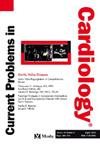评估心脏结节病合并晚期心力衰竭的预后:目前的指南如何?
IF 3.3
3区 医学
Q2 CARDIAC & CARDIOVASCULAR SYSTEMS
引用次数: 0
摘要
背景:心脏结节病(CS)影响5%至25%的系统性结节病例。CS患者可能表现为心力衰竭(HF),最终进展为晚期心力衰竭(AHF),与死亡率升高相关。目的:美国指南强调使用“I NEED HELP”标准来识别AHF患者。欧洲心脏病学会(ESC)有其他AHF诊断标准。两者都具有预测价值,但在预测CS方面的应用尚不清楚。本研究旨在解决这一问题。方法对2006年至2019年皇家布朗普顿医院109例基线左室射血分数(LVEF)为50%的患者进行分析。48例患者有≥1个与AHF一致的“I NEED HELP”标准。比较AHF和非AHF CS患者。在符合或不符合ESC-AHF标准的AHF患者之间进行亚分析。主要的综合结局指标是全因死亡率、紧急原位心脏移植或紧急左心室辅助装置插入。次要结局指标为持续性室性心动过速。结果AHF组LVEF显著降低,脑钠肽显著升高。AHF CS患者达到联合主要结局指标的比例(AHF 16/48[33%])高于非AHF组(AHF 8/61 [13%]), p <;0.019. Kaplan-Meier分析显示AHF组发生主要事件和次要事件的时间都较短(logrank p <;0.014和p <;0.040分别)。亚分析显示,ESC-AHF组的预后最差。结论在本研究中,AHA和ESC-AHF标准均具有预后价值。ESC-AHF标准最能识别预后最差的CS患者。本文章由计算机程序翻译,如有差异,请以英文原文为准。

Assessing prognostic outcomes in cardiac sarcoidosis with advanced heart failure: How do current guidelines fare?
Background
Cardiac sarcoidosis (CS) affects between 5 % to 25 % of systemic sarcoid cases. CS patients may present with heart failure (HF), with ultimate progression to advanced heart failure (AHF) associated with heightened mortality.
Objectives
American guidelines emphasise using the ‘I NEED HELP’ criteria to identify AHF patients. The European Society of Cardiology (ESC) have alternative AHF diagnostic criteria. Both have demonstrated prognostic value, but their utility in prognosticating CS is unknown. This study aimed to address this.
Methods
109 patients, with baseline left ventricular ejection fraction (LVEF) <50 %, referred to the Royal Brompton Hospital between 2006 and 2019, were analysed. 48 patients had ≥1 ‘I NEED HELP’ criteria consistent with AHF. Comparisons were made between the AHF and non-AHF CS patients. Sub-analysis was performed between the AHF patients that did or did not meet ESC-AHF criteria. Primary combined outcome measure was all-cause-mortality, urgent orthotopic cardiac transplant or urgent left ventricular assist device insertion. Secondary outcome measure was sustained ventricular tachycardia.
Results
The AHF cohort had significantly lower LVEF and higher brain natriuretic peptide values. More AHF CS patients reached combined primary outcome measure (AHF 16/48 [33 %]), than the non-AHF group (8/61 [13 %]), p < 0.019. The AHF group had shorter time to both primary and secondary events on Kaplan-Meier analysis (logrank p < 0.014 and p < 0.040 respectively). Sub-analysis revealed the ESC-AHF group had the poorest prognoses according to both outcome measures.
Conclusions
In this study, both the AHA and ESC-AHF criteria had prognostic value. The ESC-AHF criteria best identifies CS patients with poorest prognoses.
求助全文
通过发布文献求助,成功后即可免费获取论文全文。
去求助
来源期刊

Current Problems in Cardiology
医学-心血管系统
CiteScore
4.80
自引率
2.40%
发文量
392
审稿时长
6 days
期刊介绍:
Under the editorial leadership of noted cardiologist Dr. Hector O. Ventura, Current Problems in Cardiology provides focused, comprehensive coverage of important clinical topics in cardiology. Each monthly issues, addresses a selected clinical problem or condition, including pathophysiology, invasive and noninvasive diagnosis, drug therapy, surgical management, and rehabilitation; or explores the clinical applications of a diagnostic modality or a particular category of drugs. Critical commentary from the distinguished editorial board accompanies each monograph, providing readers with additional insights. An extensive bibliography in each issue saves hours of library research.
 求助内容:
求助内容: 应助结果提醒方式:
应助结果提醒方式:


